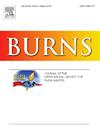在资源有限的情况下,对火焰烧伤和烫伤进行手术干预的治疗效果
IF 3.2
3区 医学
Q2 CRITICAL CARE MEDICINE
引用次数: 0
摘要
在资源有限的环境中,对最有可能从手术干预中获益的烧伤患者进行分流至关重要。本研究旨在确定在马拉维利隆圭一家三级烧伤中心接受手术干预后治疗效果更显著的烧伤患者。这是一项对2011年至2022年11月期间到卡穆祖中心医院就诊的烧伤患者进行的回顾性分析。我们根据患者是烫伤还是火焰烧伤对其进行了比较。通过逻辑回归,我们估算了手术干预对院内死亡率的调整治疗效果。手术干预的定义是烧伤切除术和清创术,无论是否植皮。我们纳入了 3266 名患者。2099例(64.7%)患者为烫伤,1144例(35.3%)为火焰烧伤。630名患者(19.3%)接受了手术治疗。所有患者的粗死亡率为 18.1%,手术患者的粗死亡率为 9.7%。根据烧伤总面积(%TBSA)和年龄进行调整后,手术对烫伤患者死亡率的平均治疗效果为-0.07(95 % CI - 0.11, - 0.033),对火焰烧伤患者的平均治疗效果为-0.17(95 % CI - 0.22, - 0.11)(图 1)。对于火焰烧伤患者,与手术相关的调整后死亡几率比为 0.26 (95 % CI 0.17, 0.39)。手术干预为火焰烧伤患者带来了生存优势,与烫伤患者相比,平均治疗效果更为显著。在资源有限的环境中,火焰烧伤应优先考虑手术治疗,而不是烫伤,以改善患者的预后。本文章由计算机程序翻译,如有差异,请以英文原文为准。
The treatment effect of operative intervention for flame versus scald burns in resource-limited settings
In resource-limited environments, it is critical to triage burn patients most likely to benefit from operative intervention. This study sought to identify patients with a more significant treatment effect after operative intervention following burn injury at a tertiary burn center in Lilongwe, Malawi. This is a retrospective analysis of burn patients presenting to Kamuzu Central Hospital from 2011 to November 2022. We compared patients based on whether they had scald or flame burns. Using logistic regression, we estimated the adjusted treatment effect of operative intervention on in-hospital mortality. Operative intervention was defined as burn excision and debridement with or without skin grafting. We included 3266 patients. 2099 (64.7 %) patients had a scald burn, and 1144 (35.3 %) had a flame burn. 630 patients (19.3 %) underwent surgery. Crude mortality among all patients was 18.1 %, and for patients who underwent surgery, it was 9.7 %. When adjusted for %TBSA (total burn surface area) and age, the average treatment effect of surgery on mortality was − 0.07 (95 % CI − 0.11, − 0.033) for patients with scald burns and − 0.17 (95 % CI − 0.22, − 0.11) for patients with flame burns (Fig. 1). For patients with flame burns, the adjusted odds ratio of death associated with surgery was 0.26 (95 % CI 0.17, 0.39). Operative intervention confers a survival advantage for patients with flame burns, and the average treatment effect was more significant compared to patients with scald burns. In resource-limited environments, flame burns should be prioritized for surgery over scald burns to improve patient outcomes.
求助全文
通过发布文献求助,成功后即可免费获取论文全文。
去求助
来源期刊

Burns
医学-皮肤病学
CiteScore
4.50
自引率
18.50%
发文量
304
审稿时长
72 days
期刊介绍:
Burns aims to foster the exchange of information among all engaged in preventing and treating the effects of burns. The journal focuses on clinical, scientific and social aspects of these injuries and covers the prevention of the injury, the epidemiology of such injuries and all aspects of treatment including development of new techniques and technologies and verification of existing ones. Regular features include clinical and scientific papers, state of the art reviews and descriptions of burn-care in practice.
Topics covered by Burns include: the effects of smoke on man and animals, their tissues and cells; the responses to and treatment of patients and animals with chemical injuries to the skin; the biological and clinical effects of cold injuries; surgical techniques which are, or may be relevant to the treatment of burned patients during the acute or reconstructive phase following injury; well controlled laboratory studies of the effectiveness of anti-microbial agents on infection and new materials on scarring and healing; inflammatory responses to injury, effectiveness of related agents and other compounds used to modify the physiological and cellular responses to the injury; experimental studies of burns and the outcome of burn wound healing; regenerative medicine concerning the skin.
 求助内容:
求助内容: 应助结果提醒方式:
应助结果提醒方式:


